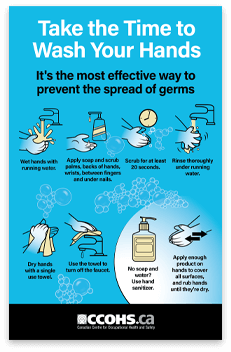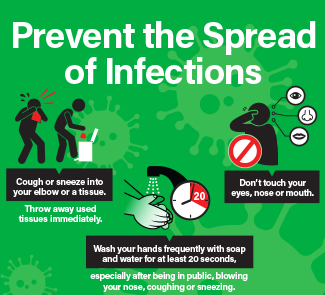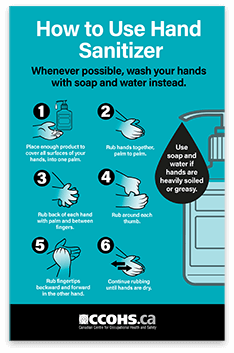Scheduled maintenance - Thursday, July 12 at 5:00 PM EDT
We expect this update to take about an hour. Access to this website will be unavailable during this time.
On Topic

Businesses and workplaces across the country will eventually reopen their doors for employees and customers to return. However, returning to the workplace after the coronavirus (COVID-19) lockdown won’t be as easy as hopping on the bus, turning on equipment, and catching up on some much-needed socializing with colleagues. Many new norms will likely replace previously established routines. Employers will need to be prudent and careful, while adhering to public health measures and legislation from their jurisdiction, in order to ensure the health and safety of their employees, their customers, and the public.
It’s important to understand that the coronavirus will still be circulating so new infections are possible. A reduction in distancing and isolation measures does not mean the virus is gone; it means that infection rates have slowed enough that the health care system is expected to be able to handle the probable cases. If infection rates increase, another period of higher restrictive measures could be reintroduced, and workplaces will need to adjust accordingly.
Employers should consider performing a deep cleaning of the facility before workers return, and make sure that good sanitation practices are in place once business resumes. Make sure washrooms are cleaned frequently and are stocked with soap, paper towels and a plastic lined waste container. Provide workers with wipes or ways to clean their workspace, and provide hand sanitizer at customer service areas, entrances and exits, checkouts, and help desks. Clean offices, lunchrooms, and workspaces at least once per day, and more often for high-traffic areas and contact surfaces. Focus on frequently touched and shared surfaces such as keys, doors, handles, phones, tables, chairs, and kitchen equipment.
Employers must do everything possible, under the circumstances, to protect the health and safety of workers and customers by providing adequate information, training, sanitation, and personal protective equipment. Set a clear policy for what is expected of workers if they get sick, have symptoms, or if an exposure is reported at the organization. Make sure staff are aware of this policy. Clearly communicate to employees before the re-opening to ensure they are informed of any changes and they are able to ask questions.
Consider having a phased-in approach when recalling workers, such as only recalling those workers that are needed for specific functions initially. Consider having some workers continue to work remotely if it is possible for them to do so. Workers living with immunocompromising health conditions (including chronic conditions such as diabetes, heart or lung issues, or cancer) or who have family members who are immunocompromised may need to continue to work remotely.
Make sure workers know about the virus and how to minimize its spread. Post signs to remind people to practice physical distancing, good respiratory etiquette, and hand hygiene. Provide enough items for each worker such as phones, tablets, walkie-talkies and tools to avoid unnecessary sharing. If items must be shared, clean them with alcohol or disinfectant wipes between users.
Some changes to business operation may be required to accommodate physical distancing. Spread out workers by using every other workstation or setting up spare rooms or meeting areas as workspaces. Stagger working hours to avoid the use of public transit during peak times, and to give workers enough space during the day. Consider how people will use shared spaces such as the cafeteria, lunchroom, hallways, changing rooms, and washrooms. Keep close contact to a minimum and less than 15 minutes. Allow only one person at a time if spacing cannot be maintained. Post signs to indicate the space is being used.
Continue to postpone non-essential face-to-face events or meetings. Reschedule or limit appointments with suppliers, vendors, service technicians and others where possible. Manage pedestrian traffic flow by using markings, posters or barriers.
Understand that each person will have had a different experience and reaction to the pandemic, and to the physical distancing and isolation measures. Some individuals may be excited and ready to reintegrate into everyday activities, while others may wish to exercise caution and continue to practice physical distancing. Provide information and reassurance about the measures the workplace is taking. Be ready to address any anxiety or fear that may be expressed. An individual may be experiencing grief over the loss of a friend or family member, and workplaces will need to be compassionate.
While many people recover from COVID-19 without needing hospitalization, estimates are that 1 in 6 become severely ill. While the knowledge of this illness and its effects will continue to grow, it appears that individuals who required intensive care may continue to be challenged by muscle weakness, and problems with memory and concentration. In some cases, patients take a long time before they can return to work. Collaboration with the worker will be necessary to develop and support an appropriate accommodation plan for return to work when needed.
Keep in mind that every business is unique and there is no one-size-fits-all approach for reopening. It is important to follow any physical distancing or safety measures that remain necessary, monitor announcements for your area, and follow the latest instructions from the government, public health, or other appropriate authority.
Resources
Hazard Alert

To address a possible shortage of cleaning supplies containing chemicals effective against the COVID-19 virus in Canada, Health Canada has put in place an interim policy that will allow quicker imports of products from the United States. See their hazard alert. Make sure your employees know how to safely handle these products as the labelling may be different.
Temporary changes and legislative requirements
The interim policy applies to the following types of products imported from the United States only:
These products may be sold to Canadian workplaces with U.S. labelling and safety data sheets (SDS). Important information will still be present, but the product labelling and SDS may appear different.
How these changes may affect your workplace
Employers will still need to understand and comply with their jurisdiction’s occupational health and safety legislation and purchase cleaning products that are intended for use in the workplace. You are also required to educate and train workers on all hazards associated with the products that are used, or stored for use, in the workplace. If you do buy and use products covered under this interim policy, you are encouraged to refer to the links provided by the supplier and to communicate it to your employees. These products may have differences (e.g., unilingual labelling, information or pictograms not exactly as outlined in the Hazardous Products Regulations) that will require you to provide supplemental training and education. Federally-regulated workplaces can consult the Employment and Social Development Canada Labour Program hazard alert.
Podcasts

This month’s feature podcasts are Maintaining Our Health When Working Remotely and Socially Bridge the Physical Distance.
Podcast: Maintaining Our Health When Working Remotely
The coronavirus (COVID-19) pandemic has challenged employers to equip their workers with the tools they need in order to do their jobs safely at home, and it’s important that this focus includes both mental and physical health. Learn more about what employers and workers can do.
The podcast runs 4:14 minutes. Listen to the podcast now.
Podcast: Socially Bridge the Physical Distance
The COVID-19 global pandemic is a challenging time. Preparation, positivity, and patience go a long way to protecting our collective health as we all navigate through this unprecedented event together. However, feeling anxious along the way is understandable. Here are some tips to help maintain connections and stay mentally well.
The podcast runs 3:24 minutes. Listen to the podcast now.
CCOHS produces free monthly podcasts on a wide variety of topics designed to keep you current with information, tips, and insights into the health, safety, and well-being of working Canadians. You can download the audio segment to your computer or MP3 player and listen to it at your own convenience... or on the go!
See the complete list of podcast topics. Better yet, subscribe to the series on iTunes and don't miss a single episode. Listen on Spotify.
CCOHS News

Workplaces still need to be vigilant about COVID-19 after reopening for business. Reinforce good habits to help prevent the spread of infection. CCOHS offers free downloadable posters on good hygiene etiquette to help you protect the health and safety of your employees, customers and the public during the pandemic.
| Take the Time to Wash Your Hands | Prevent the Spread of Infections | How to Use Hand Sanitizer |
 |
  |
 |
CCOHS has other helpful resources, courses, and PDF guides available free of charge.
View the complete list of available resources.
Infographic

Ladders are common to almost every home and workplace, giving the impression that ladder work requires no special knowledge or skills. But anyone who uses a ladder should have hands-on safety training to learn about the various risks involved and the precautions necessary to prevent falling. Every year, a significant number of injuries occur when people use ladders at work or at home.
Share this infographic with tips on inspecting, setting up and working from a ladder, along with some employer responsibilities to ensure that ladders are used safely in the workplace.
Legislation

It can be challenging to keep up with ever-changing occupational health and safety legislation. This month we highlight an amendment to the federal Quarantine Act and amendments to provincial legislation in Prince Edward Island, British Columbia, Ontario, and the Northwest Territories.
The federal Quarantine Act was recently amended to include COVID-19 coronavirus disease in the list of communicable diseases found in the Schedule.
Prince Edward Island
Prince Edward Island has made major amendments to the Occupational Health and Safety Act General Regulations including revoking Part 49 of the regulations and substituting a new Part 49 pertaining to asbestos; amending section 1.6 to provide gender neutral language; amending section 11.3 to update the reference to the publication that prescribes the suitable means of ventilation that is to be provided by an employer to reduce contamination in the air of working areas; and, repealing and replacing subsection 45.18(1) to update the CSA Standard required to be used by an employer to ensure that the selection, use and care of respirators meet applicable standards and specifications. (Amended by EC2020-147)
British Columbia
On April 6, 2020, four British Columbia regulations under the Workers’ Compensation Act were amended. These include: Fishing Industry Regulations; Occupational Disease Recognition Regulation; Occupational Health and Safety Regulation; and Reports of Injuries Regulations.
Ontario
Ontario’s Occupational Health and Safety Awareness Training was amended to include subsection 8(2) relating to the validity of working at heights training completed between February 28, 2017 and August 31, 2017.
The Northwest Territories
The Northwest Territories’ Workers' Compensation Act was amended extensively to: clarify use of the terms "impairment" and "disability"; add detail respecting who is considered an "employer" within the scope of the Act; remove the requirement for a primary health care provider; clarify the compensation paid to a dependent child of a deceased worker; add unemployment benefits as a category of remuneration; authorize information sharing and disclosure for the purpose of improving administration of the Act; enable an inspector to inspect health care providers’ records to verify services received; and, correct inconsistencies and errors identified in the Act.
For more information regarding recent regulatory changes CCOHS offers a paid subscription service, Canadian enviroOSH Legislation plus Standards, that provides a collection of all the health, safety and environmental legislation you need in one location.
The Health and Safety Report, a free monthly newsletter produced by the Canadian Centre for Occupational Health and Safety (CCOHS), provides information, advice, and resources that help support a safe and healthy work environment and the total well being of workers.
You can unsubscribe at any time. If you have been sent this newsletter by a friend, why not subscribe yourself?
Concerned about privacy? We don’t sell or share your personal information. See our Privacy Policy.
CCOHS 135 Hunter St. E., Hamilton, ON L8N 1M5
1-800-668-4284 clientservices@ccohs.ca
www.ccohs.ca
© 2025, Canadian Centre for Occupational Health and Safety
Podcast
December 10
October 28-29, 2026